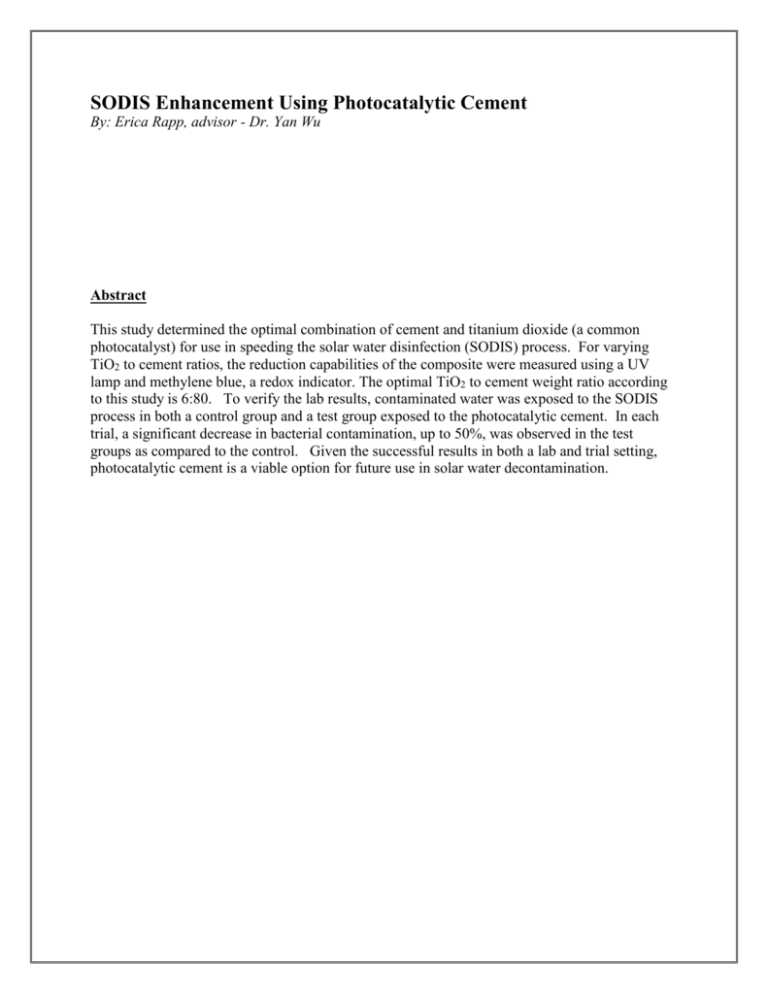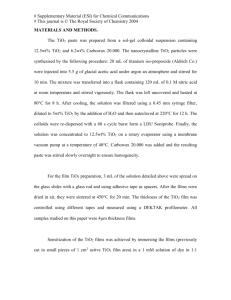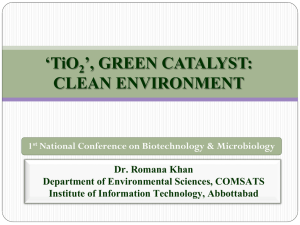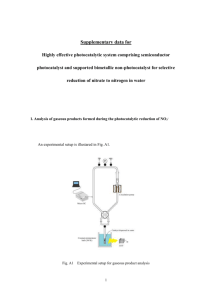SODIS Enhancement Using Photocatalytic Cement
advertisement

SODIS Enhancement Using Photocatalytic Cement By: Erica Rapp, advisor - Dr. Yan Wu Abstract This study determined the optimal combination of cement and titanium dioxide (a common photocatalyst) for use in speeding the solar water disinfection (SODIS) process. For varying TiO2 to cement ratios, the reduction capabilities of the composite were measured using a UV lamp and methylene blue, a redox indicator. The optimal TiO2 to cement weight ratio according to this study is 6:80. To verify the lab results, contaminated water was exposed to the SODIS process in both a control group and a test group exposed to the photocatalytic cement. In each trial, a significant decrease in bacterial contamination, up to 50%, was observed in the test groups as compared to the control. Given the successful results in both a lab and trial setting, photocatalytic cement is a viable option for future use in solar water decontamination. Table of Contents Introduction………………………………………………………………………………..........2-4 Materials………………………………………………………………………………..……….4-5 Procedure………………………………………………………………………….…………….5-7 Results and Discussion……………………………………………………………………...…7-11 Conclusions……………………………………………………………………………….……11 References………………………………………………………………………………...….12-13 Appendix A – Methylene Blue Reduction using Aggregate TiO2……………………………….14 Appendix B – Methylene Blue Reduction using Photocatalytic Composites……………………15 Appendix C – Petrifilm Trial Bacterial Colony Counts……………………………………...16-18 1 Introduction In a vast number of developing countries, there is a shortage of clean water to use in sanitation and consumption. More than 3.4 million people die each year due to water-borne illnesses – a majority of them are children who have been forced to rely on unclean water sources. (1; 2). Due to the overwhelming need for potable water, a great deal of study has gone into the science of water decontamination (3; 4; 5; 6; 7). This study focuses on one method in particular: solar water disinfection (SODIS). The SODIS method promotes the inactivation of microbes present in water through UV radiation and by creating a high temperature environment (7). UV rays alter bacterial DNA and create an oxidizing environment detrimental to diseasecausing organisms (2; 7). Most communities that use SODIS implement clear plastic bottles (PET bottles), fill them with water, and let them sit in the sun anywhere from 6 hours to 2 days. The amount of time needed depends on the amount of sunlight present and the turbidity of the water. Benefits of SODIS include a significant decrease in water-borne illnesses, simple implementation, a low rate of recontamination, no additives, and little to no alteration of water taste (2). SODIS has been hailed as one of the most cost-effective water purifications methods – the only monetary requirements involve acquiring PET bottles (2; 4). Analysts predict that ultimately eliminating disease caused by unclean water would reap a benefit of $3-$34 USD for every $1 spent in treatment implementation (1). Despite this, there are drawbacks which prevent SODIS from being used on a larger scale. Unfortunately, SODIS can only purify a finite amount of water at once. In large, this is due to the length of time needed for purification and the limited volume allowed by plastic bottles. One attempt to alleviate this concern employs the use of photocatalysts to speed the SODIS process. A photocatalyst is a substance which accelerates a chemical reaction using 2 sunlight – in this experiment, titanium dioxide (TiO2) was used. As shown in Figure 1, UV light reaches the photocatalyst and creates hydroxyl radicals which then inactivate harmful microorganisms (3). Figure 1 - The mechanism by which TiO2 breaks down harmful microbes (8) Past experiments using photocatalysts to speed SODIS have used either a thin film of TiO2 lining the inner wall of the bottle or left it suspended in the water. With the first method, TiO2 eventually washes away leaving nothing but the plastic bottle. Taking the time to deposit the titanium dioxide in a thin film also requires expertise, time, and money that many developing countries do not have. Leaving the photocatalyst suspended in water only allows for one use and must be filtered out before consumption (5). To alleviate these concerns, the work presented in this study examines the long-term effectiveness of a cement and TiO2 mixture in enhancing the SODIS method. Photocatalytic cement is not a new idea; it simply has not seen widespread use in water purification. Presently, buildings and roads made of cement mixed with TiO2 are being used in Europe to cut down on pollution and dirt buildup. A study conducted in the Netherlands 3 demonstrated that nitrogen oxide levels on roadways made of photocatalytic cement were reduced by 25-45% (9). Since pollution is a prominent issue in the modern day, there have been entire businesses founded on the production of photoactive cement (9; 10). Materials Four materials in particular were used in the course of this study: TiO2, methylene blue, portland cement, and 3M petrifilmTM. To create the photocatalytic compound, TiO2 was mixed with cement. P-25 Degussa, an industrial standard TiO2 powder consisting of anatase and rutile phases in a 3:1 ratio was used for this study. The effectiveness of the compound was then measured using methylene blue. Once the most effective compound was ascertained, the petrifilms were used to measure bacterial contamination of river water upon exposure to the enhanced SODIS process. Each material is discussed in detail in this section. Although there are many photocatalysts available, TiO2 displays optimal properties for use with SODIS. It is chemically non-reactive, easily obtainable due to heavy use in industry and research, and non-poisonous. The anatase phase of TiO2 in particular performs well in photoactive applications (3; 11). During exposure to UV light, TiO2 reacts by absorbing a photon and releasing an electron-hole pair in response. To do this, the photon must be greater than the bandgap energy of the material it comes in contact with (anatase TiO2 has a bandgap energy of 3.25 eV). The hole is then free to oxidize organics and the electron goes on to react with reducible molecules as seen in Figure 1 (8; 5). No other photocatalyst considered for this study was able to offer the same versatility and flexibility. Methylene blue is a common redox indicator. During exposure to reducing agents, a solution of methylene blue begins to turn colorless. The subsequent change in absorption spectrum is then measured using a spectrometer. Generally, the change in optical density of the 4 peak wavelength (664 nm for methylene blue) is recorded. The rate of change in the MB absorption spectrum reflects the rate at which SODIS would reduce organics (12). Portland cement was used as a binding agent in this study. It was chosen because it is cost effective, chemically non-reactive, porous for increased surface area, and simple to work with (13). 3M PetrifilmTM is used as a culture template. Each plate contains nutrients, a gelling agent, and an indicator which turns either red or blue in the presence of bacterial colonies. Red coloring is apparent in coliforms and a blue color indicates E.coli. One petrifilm plate is able to sample up to 1 mL of water (14). Procedure A methylene blue solution was created using MB powder and deionized water. Each test within this study used a 10 ppm methylene blue solution as an initial indicator. UV light used to degrade the MB solution was provided by a Mineralight Multiband UVGL-25 lamp with light wavelengths of 254/366 nm. The absorption spectrum was measured using a SpectraSuite spectrometer. Maximum effectiveness of the TiO2 powder was ascertained by mixing it directly into the MB solution, exposing it to UV light, and measuring the absorption spectrum change over 3 hours. Tested concentrations of TiO2 included 0.5, 1.0, and 1.5 g/L. These were based off of previous studies which found that the optimal titanium dioxide concentration was centered about 1.0 g per liter of MB solution (12; 15). Thorough mixing of the TiO2 and cement was an important consideration in the effectiveness of the compound. Two methods were compared to determine whether manual mixing detracted from the end results: a planetary ball mill and mixing by hand. The planetary 5 ball mill used ceramic balls and rotational motion to thoroughly mix the composite. Manual mixing was conducted by carefully measuring both cement and TiO2 powder into a plastic bag and proceeding to shake the bag for ten minutes. If clumps of either material were present afterwards, additional mixing was employed until a powder with consistent texture and color was attained. Due to very little change in results, the manual method was used for each tested ratio. Tested weight ratios of TiO2 to cement were: 3:80, 4:80, 5:80, 6:80, and 7:80. These ratios were initially based upon previous photocatalytic composite studies with optimal results centered about 5 grams of photocatalyst per 125 grams of binding agent (16). Once water was added to the powder, the composite was applied to the lower portion of a t-plate for each mixture (see in Figure 2). After the composite dried, it was lowered onto an 80mL beaker filled with methylene blue. In this manner, a set amount of the MB solution could be exposed to UV light with varying composite mixtures. This setup eliminated variations in acquired data by keeping the amount of MB the same, keeping composite surface area consistent, and allowing for multiple tests of the same composite sample. Figure 2 - T-plate to which the wet cement mixture was applied. 6 Once the optimal ratio was determined, a rod made of the photocatalytic cement was created for use in a 16.9 oz. PET bottle. The rod was modeled as a cylinder with a length of 12 cm and diameter of 1.5 cm. To test the rod, two 16.9 oz. plastic bottles were filled with water from the Rountree Branch of the Little Platte River in Platteville, WI. One bottle contained the cylinder while the other acted as a control. At given time intervals, 1 mL of water from each bottle was deposited on a petrifilm. The petrifilms required an incubation period of 48 hours at which time the number of bacterial colonies were recorded. This process was repeated twice; once using natural sunlight, and once using the UV lamp. During the natural sunlight trial, the bottles were placed on a black metal surface during sunny conditions. Results and Discussion The concentration of aggregate titanium dioxide in solution which displayed optimal reduction capabilities was 1 g/L. To support this, Figure 3 displays percent reduction after three hours according to grams of TiO2 added to one liter of MB solution. Figure 4 depicts the resulting spectral image from which changes in absorption spectrum data were taken. Percent reduction was calculated through measuring the change in absorbance of MB’s peak wavelength (664 nm) between the initial time and 3 hours (also see Appendix A). 7 Percent Reduction of MB in 3 Hours 45 40 35 30 25 20 0.4 0.6 0.8 1 1.2 grams of TiO2 per Liter of MB Solution 1.4 1.6 Figure 3 - Graphical evidence confirming 1.0 g/L as the optimal TiO2 concentration Figure 4 - Spectrometer image of a MB solution degraded over 3 hours using 1 g TiO2 per L MB concentration. 8 The results were consistent with those found in previous studies (12; 15). This provided validity to the process by which the photocatalytic composite efficiency was determined. It also defined an accurate standard by which to compare the composite results. Each composite mixture underwent multiple trials of methylene blue degradation to determine which was optimal. The effectiveness of the composite was determined by looking at the percent of MB reduced over the course of 3 hours in the same manner used for aggregate TiO2 (see Figure 5). A TiO2 to cement ratio of 6:80 (3:40 or 7.5 wt%) proved to be the most efficient in terms of reduction speed. Percent Reduction of MB in 3 hrs 24 22 20 18 16 14 12 10 2 3 4 5 6 Grams of Tio2 mixed with 80 g Cement 7 Figure 5 - Each composite mixture and its reduction capability over the course of 3 hours. Although the 7:80 composite performed adequately, there were qualitative problems with it. The high concentration of titanium dioxide made the composite more prone to breaking and crumbling. Higher concentrations of TiO2 were attempted in ratios of 8:80 and 9:80, but each ended up cracking apart. It is possible that other materials could be added to the mixture to prevent this phenomenon, but when using only TiO2 and cement, the ratio limit is 7:80. 9 The photocatalytic cement rod used to purify contaminated water was created using a 6:80 ratio of titanium dioxide and cement. Its reduction capabilities were measured using a bacteria count instead of methylene blue. For each trial, the total bacteria count was lower in the bottle containing the photocatalytic rod. The recorded bacteria counts including both E.coli and coliforms for each trial can be seen in Figure 6 and 7. 190 180 E.Coli/Coliform Count 170 160 150 140 TiO2 130 Control 120 110 100 0 30 60 Time (min) 90 120 Figure 6 – Average E.Coli/Coliform count present in 1 mL of water over a period of 2 hours when exposed to a UV lamp. 190 180 E.Coli/Coliform Count 170 160 150 TiO2 140 Control 130 120 110 100 0 30 60 Time (min) 90 120 Figure 7 - Average E.Coli/Coliform count present in 1 mL of water over a period of 2 hours when exposed to natural sunlight. 10 While both graphs report a higher bacterial reduction rate for water exposed to the photocatalytic composite, the rate is slower in the trial using natural sunlight. This can be accounted for by taking into consideration lower temperatures and a UV index of only 4 for the natural sunlight trial. The relevance of these results lies purely in their reduction speed relative to that of the control trials. Each trial consistently concluded that the tested photocatalytic cement composite increased the rate at which SODIS took place. Conclusions In many parts of the world, access to sanitary water is limited. Photocatalytic enhancement of the SODIS method offers an inexpensive way to bolster water disinfection processes already being used to counteract this disparity. While the use of titanium dioxide to its full potential (in an aggregate solution) is able to reduce 41.5% of pathogens in 3 hours, it is not a feasible plan for enhancing SODIS. Photocatalytic cement offers a sanitary, inexpensive, and reusable alternative which, according to this study, is able to reduce up to 22.5% of pathogens in the same time. The optimal ratio of titanium dioxide and Portland cement used to create this composite is 3:40. Based on the results of this study, photocatalytic cement is a viable tool for use in solar water disinfection. In future studies, it is recommended that water in contact with the composite be tested to see if aggregate TiO2 is escaping into the system. If this is the case, it is probable that the composite actually has a lower reduction rate than that reported in this study. Another variable to change in the future is the binding agent material. 11 References 1. Berman, Jessica. WHO: Waterborne Disease is World's Leading Killer. Voice of America. [Online] October 29, 2009. http://www.voanews.com/content/a-13-2005-03-17-voa34-67381152/274768.html. 2. Center for Disease Control. Household Water Treatment Options in Developing Countries: Solar Disinfection (SODIS). Center for Disease Control. [Online] January 2008. http://www.cdc.gov/safewater/publications_pages/options-sodis.pdf. 3. Photocatalytic Enhancement for Solar Disinfection of Water: A Review. Byrne, J. Anthony, et al., et al. [ed.] Mohamed Sabry Abdel-Mottaleb. s.l. : Hindawi Publishing Corporation, December 24, 2010, International Journal of Photoenergy, Vol. 2011. 4. Cost-effectiveness of Water Quality Interventions for Preventing Diarrhoeal Disease in Developing Countries. Clasen, Thomas, et al., et al. 4, s.l. : IWA Publishing, 2007, Journal of Water and Health, Vol. 5. 5. Photocatalytic Destruction of Water Pollutants Using TIO2 Film in PET Bottles. Heredia, Manuel and Duffy, John. Lowell, MA : s.n., 2006. 6. Kurup, Deepika, [perf.]. Discovery Education 3M Young Scientist Challenge. News Broadcast Network, 2012. 7. Optimizing the Solar Water Disinfection (SODIS) Method by Decreasing Turbidity with NaCl. Pearce, Joshua M. and Dawney, Brittney. 2, s.l. : Journal of Water, Sanitation, and Hygiene for Development, 2012, Vol. 2. 8. Fujishima, Akira. Basic Mechanism of TiO2 Photocatalysis and a Recent Application. Photocatalyst Group. s.l. : Kanagawa Academy of Science and Technology. 9. Self-Cleaning Concrete: Building a Better (Cleaner) World in the 21st Century. Concrete Technology. [Online] 2013. http://www.cement.org/tech/self_cleaning.asp. 10. Photocatalytic Cements. TX Active. [Online] http://txactive.us/. 11. Background. Photocatalysis. [Online] 2012. http://www3.nd.edu/~kamatlab/research_photocatalysis.html. 12. Experimental Study of Influencing Factors and Kinetics in Catalytic Removal of Methylene Blue with TiO2 Nanopowder. Salehi, Marziyeh, Hashemipour, Hassan and Mirzaee, Mohammad. 1, s.l. : Scientific & Academic Publishing, American Journal of Environmental Engineering, Vol. 2, pp. 1-7. 13. Burton, Maria Christina. Pervious Concrete With Titanium Dioxide as a Photocatalyst Compound for a Greener Urban Road Environment. Civil Engineering, Washington State University. 2011. Thesis. 12 14. 3M. 3M Petrifilm E.Coli/Coliform Count Plate. Interpretation Guide. [Online] 2008. http://multimedia.3m.com/mws/mediawebserver?66666UuZjcFSLXTt4XMa4xTaEVuQEcuZgVs6EVs6E66 6666--. 15. Titamium Oxide (TiO2) Assisted Photocatalytic Degradation of Methylene Blue. Madhu, G.M., Lourdu Antony Raj, M.A. and Vasantha Kumar Pai, K. 2, October 16, 2007, Journal of Environmental Biology, Vol. 30. 16. Discovery Education 3M Young Scientist Challenge. [Online] News Broadcast Network, 2012. http://www.youtube.com/watch?v=71c95-LoBok. 17. Berman, Jessica. WHO: Waterborne Disease is World's Leading Killer. Voice of America. [Online] October 29, 2009. 13 Appendix A – Methylene Blue Reduction using Aggregate TiO2 Table A1 - Various concentrations of aggregate TiO2 were tested to determine maximum reduction capabilities. Amount of aggregate TiO2 within MB solution (g/L) 1 1.5 0 0.94 0.94 0.94 15 0.89 0.88 0.9 30 0.86 0.85 0.87 45 0.82 0.8 0.85 60 0.78 0.75 0.8 90 0.73 0.7 0.76 120 0.7 0.63 0.72 150 0.67 0.57 0.7 180 0.64 0.55 0.69 % Degradation in 2 hours 25.5% 33.0% 23.4% % Degradation in 3 hours 31.9% 41.5% 26.6% Optical Density Time (min) 0.5 1 0.95 Optical Density 0.9 0.85 0.8 0.75 0.5 g/L 0.7 1.0 g/L 0.65 1.5 g/L 0.6 0.55 0.5 0 50 100 150 200 Time (min) Figure A1 - TiO2 concentrations and the reduction over time. 14 Appendix B – Methylene Blue Reduction using Photocatalytic Composites Table B1 - Various TiO2:cement ratios were tested to determine their reduction efficiency. 0 15 30 45 60 3:80 0.929 0.897 0.892 0.871 0.864 3:80 (Ball Mill) 0.929 0.899 0.896 0.875 0.867 4:80 0.954 0.932 0.909 0.902 0.900 5:80 0.969 0.933 0.928 0.882 0.871 6:80 0.958 0.929 0.920 0.879 0.865 7:80 0.952 0.935 0.916 0.892 0.876 90 120 150 0.850 0.823 0.803 0.848 0.825 0.802 0.884 0.866 0.841 0.832 0.823 0.811 0.828 0.787 0.762 0.860 0.831 0.785 180 0.792 0.791 0.828 0.811 0.742 0.772 Δ OD 0.137 0.138 0.126 0.158 0.216 0.180 % MB Reduction 14.7% 14.9% 13.2% 16.3% 22.5% 18.9% Optical Density 1.000 0.950 0.900 Optical Density Time TiO2:Cement Ratio 3g:80g 3g:80g (B) 0.850 4g:80g 5g:80g 0.800 6g:80g 0.750 7g:80g 0.700 0 50 100 150 200 Time (min) Figure B1 - Optical density was plotted with respect to time for each composite. 15 Appendix C – Petrifilm Trial Bacterial Colony Counts Table C1 - Bacterial colonies present in 1 mL of water from both a control bottle and one containing the photocatalytic cement were recorded over given time intervals in the trial using a UV lamp. Coliform and E.Coli Count - UV Light Trial TiO2 Trial 1 Trial 2 Average Control Trial 1 Trial 2 Average 163 175 0 187 163 175 15 30 45 165 155 148 148 139 145 156.5 147 146.5 15 30 45 177 167 172 175 159 161 176 163 166.5 60 90 140 133 131 136 135.5 134.5 60 90 164 159 158 144 161 151.5 120 122 118 120 120 151 149 150 Time (min) 187 % MB Reduction 31.4% Bacteria Colony Count 0 14.3% Table C2 – The number of blue-colored E.Coli colonies present within 1 mL of water were recorded at set time intervals during the UV light trial. E.Coli Count - UV Light Trial Trial 1 Trial 2 Average Control Trial 1 Trial 2 Average 0 7 8 7.5 0 7 8 7.5 15 4 4 4 15 6 5 5.5 30 3 2 2.5 30 6 6 6 45 3 0 1.5 45 5 3 4 60 90 4 2 3 0 3.5 1 60 90 6 3 6 7 6 5 120 2 1 1.5 120 5 7 6 % Reduction 80.0% E.Coli Colony Count Time (min) TiO2 20.0% 16 8 7 E.Coli Colony Count 6 5 4 Control 3 TiO2 2 1 0 0 50 100 Time (min) Figure C1 - E.Coli levels from Table C2 were recorded with respect to time. Table C3 - Bacterial colonies present in 1 mL of water from both a control bottle and one containing the photocatalytic cement were recorded over given time intervals in trial using natural sunlight. E.Coli and Coliform Count - Natural Sunlight Trial Trial 1 Trial 2 Average Control Trial 1 Trial 2 Average 0 187 163 175 0 187 163 175 15 30 45 177 171 168 162 169 144 169.5 170 156 15 30 45 179 171 178 182 164 175 180.5 167.5 176.5 60 90 156 152 155 146 155.5 149 60 90 173 166 169 165 171 165.5 120 146 131 138.5 120 156 167 161.5 % Reduction 20.9% Bacteria Colony Count Time (min) TiO2 7.7% 17 Table C4 – The number of blue-colored E.Coli colonies present within 1 mL of water were recorded at set time intervals during the natural sunlight trial. E.Coli Count - Natural Sunlight Trial TiO2 4 6 5 15 5 7 6 30 45 60 90 7 5 4 6 8 8 6 7 7.5 6.5 5 6.5 30 45 60 90 5 6 6 4 8 7 6 6 6.5 6.5 6 5 120 5 6 5.5 120 6 6 6 Time (min) 15 % Reduction 26.7% E.Coli Colony Count Trial 1 Trial 2 Average Control Trial 1 Trial 2 Average 0 7 8 7.5 0 7 8 7.5 20.0% 8 7 E.Coli Count 6 5 4 Control 3 TiO2 2 1 0 0 50 Time (min) 100 FigureC2 - E.Coli levels from Table C4 were recorded with respect to time. 18




